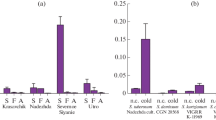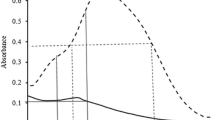Abstract
As the fourth most important food crop, potato plays a key role in food safety and economic development of the world. Harvested potato tubers can be stored for a long time, but sprouting and cold-induced sweetening (CIS) can seriously affect the quality of tubers during storage. One of the key pathways involved in CIS is starch degradation, in which both α-amylase and β-amylase play important roles. However, each amylase belongs to an extensive gene family and it is not clear which genes are the key regulators. In this study, we identified genes most likely regulating starch degradation. We first selected candidate genes from the public potato genome database and then investigated their expression patterns associated with reducing sugars and amylase activities. The results showed that the activity of α-amylase was mainly caused by StAmy23 and the activity of β-amylase was mainly caused by StBAM1 and StBAM7. In addition, α-amylase and β-amylase may play important roles in starch degradation of the tubers stored at low temperature and during sprouting, and the amylase activity may be regulated by the amylase inhibitor in cold-stored tubers.






Similar content being viewed by others
References
Bailey K, Phillips I, Pitt D (1978) The role of buds and gibberellin in dormancy and the mobilization of reserve materials in potato tubers. Ann Bot 42:649–657
Bhaskar PB, Wu L, Busse JS, Whitty BR, Hamernik AJ, Jansky SH, Buell CR, Bethke PC, Jiang J (2010) Suppression of the vacuolar invertase gene prevents cold-induced sweetening in potato. Plant Physiol 154:939–948
Biemelt S, Hajirezaei M, Hentschel E, Sonnewald U (2000) Comparative analysis of abscisic acid content and starch degradation during storage of tubers harvested from different potato varieties. Potato Res 43:371–382
Brisson N, Giroux H, Zollinger M, Camirand A, Simard C (1989) Maturation and subcellular compartmentation of potato starch phosphorylase. Plant Cell 11:559–566
Chen X (2012) Identification and profiling of the genes associated with cold-induced sweetening in Solanum berthaultii. Dissertation, Huazhong Agricultural University
Chen X, Song B, Liu J, Yang J, He T, Lin Y, Zhang H, Xie C (2012) Modulation of gene expression in cold-induced sweetening resistant potato species Solanum berthaultii exposed to low temperature. Mol Genet Genomics 287:411–421
Claassen PA, Budde MA, Van Calker MH (1993) Increase in phosphorylase activity during cold-induced sugar accumulation in potato tubers. Potato Res 36:205–217
Cottrell J, Duffus C, Paterson L, Mackay G, Allison M, Bain H (1993) The effect of storage temperature on reducing sugar concentration and the activities of three amylolytic enzymes in tubers of the cultivated potato, Solanum tuberosum L. Potato Res 36:107–117
Davies H, Viola R (1988) The effect of gibberellic acid on starch breakdown in sprouting tubers of Solanum tuberosum L. Ann Bot 61:689–693
Fulton DC, Stettler M, Mettler T, Vaughan CK, Li J, Francisco P, Gil M, Reinhold H, Eicke S, Messerli G, Dorken G, Halliday K, Smith AM, Smith SM, Zeeman SC (2008) β-AMYLASE4, a noncatalytic protein required for starch breakdown, acts upstream of three active β-amylases in Arabidopsis chloroplasts. Plant Cell 20:1040–1058
Hartmann A, Senning M, Hedden P, Sonnewald U, Sonnewald S (2011) Reactivation of meristem activity and sprout growth in potato tubers require both cytokinin and gibberellin. Plant Physiol 155:776–796
Hill LM, Reimholz R, SchrÖder R, Nielsen TH, Stitt M (1996) The onset of sucrose accumulation in cold-stored potato tubers is caused by an increased rate of sucrose synthesis and coincides with low levels of hexose-phosphates, an activation of sucrose phosphate synthase and the appearance of a new form of amylase. Plant Cell Environ 19:1223–1237
Horvath DP, Anderson JV, Chao WS, Foley ME (2003) Knowing when to grow: signals regulating bud dormancy. Trends Plant Sci 8:534–540
Li W, Shao Y, Chen W (2005) Improved method for determining amylase activity. Plant Physiol Commun 41:655–656
Liu X, Song B, Zhang H, Li X-Q, Xie C, Liu J (2010) Cloning and molecular characterization of putative invertase inhibitor genes and their possible contributions to cold-induced sweetening of potato tubers. Mol Genet Genomics 284:147–159
Lorberth R, Ritte G, Willmitzer L, Kossmann J (1998) Inhibition of a starch-granule-bound protein leads to modified starch and repression of cold sweetening. Nat Biotechnol l16:473–477
Malone JG, Mittova V, Ratcliffe RG, Kruger NJ (2006) The response of carbohydrate metabolism in potato tubers to low temperature. Plant Physiol 47:1309–1322
Morrell S, Rees TA (1986) Control of the hexose content of potato tubers. Phytochemistry 25:1073–1076
Nicot N, Hausman JF, Hoffmann L, Evers D (2005) Housekeeping gene selection for real-time RT-PCR normalization in potato during biotic and abiotic stress. J Exp Bot 56:2907–2914
Ou Y, Song B, Liu X, Lin Y, Zhang H, Li M, Fang H, Liu J (2013) Profiling of StvacINV1 expression in relation to acid invertase activity and sugar accumulation in potato cold-stored tubers. Potato Res 56:1–9
Preiss J (1982) Regulation of the biosynthesis and degradation of starch. Ann Rev Plant Physiol 33:431–454
Rentzsch S, Podzimska D, Voegele A, Imbeck M, Müller K, Linkies A, Leubner-Metzger G (2012) Dose-and tissue-specific interaction of monoterpenes with the gibberellin-mediated release of potato tuber bud dormancy, sprout growth and induction of α-amylases and β-amylases. Planta 235:137–151
Rohde A, Ruttink T, Hostyn V, Sterck L, Van Driessche K, Boerjan W (2007) Gene expression during the induction, maintenance, and release of dormancy in apical buds of poplar. J Exp Bot 58:4047–4060
Scheidig A, Fröhlich A, Schulze S, Lloyd JR, Kossmann J (2002) Downregulation of a chloroplast-targeted β-amylase leads to a starch-excess phenotype in leaves. Plant J 30:581–591
Shepherd LVT, Bradshaw JE, Dale MFB, McNicol JW, Pont SDA, Mottram DS, Davies HV (2010) Variation in acrylamide producing potential in potato: segregation of the trait in a breeding population. Food Chem 123:568–573
Solomos T, Mattoo AK (2005) Starch-sugar metabolism in potato (Solanum tuberosum L.) tubers in response to temperature variations. In: Razdan MK and Mattoo AK (ed) Genetic Improvement of Solanaceous Crops, 1st edn. Plymouth: 209–234
Suttle JC (1995) Postharvest changes in endogenous ABA levels and ABA metabolism in relation to dormancy in potato tubers. Physiol Plant 95:233–240
Suttle JC (2004) Involvement of endogenous gibberellins in potato tuber dormancy and early sprout growth: a critical assessment. J Plant Physiol 161:157–164
Talburt WF, Schwimmer S, Burr HK (1975) Structure and chemical composition of the potato tuber. In: Talburt WF and Smith O (eds) Potato processing, 2nd edn. AVI publishing, Westport, Connecticut, pp 11–46.
Tompson JD, Gibson TJ, Plewniak F, Jeanmougin F, Higgins DG (1997) The Clustal X windows interface: flexible strategies for multiple sequence alignment aided by quality analysis tools. Nucleic Acids Res 25:4876–4882
Valerio C, Costa A, Marri L, Issakidis-Bourguet E, Pupillo P, Trost P, Sparla F (2011) Thioredoxin-regulated beta-amylase (BAM1) triggers diurnal starch degradation in guard cells, and in mesophyll cells under osmotic stress. J Exp Bot 62:545–555
Zhang H, Liu X, Liu J, Ou Y, Lin Y, Li M, Song B, Xie C (2013) A novel RING finger gene, SbRFP1, increases resistance to cold-induced sweetening of potato tubers. FEBS Lett 587:749–755
Acknowledgments
We thank Prof. Dr. Uwe Sonnewald and Dr. Jingcai Li for useful discussion and Stephen Reid and Dr. Juan Du for language editing. This research was supported by grants from the National Science Foundation of China (31171602) and the National High Technology Research and Development Program of China (2009AA10Z103).
Author information
Authors and Affiliations
Corresponding author
Additional information
Huiling Zhang and Juan Hou contributed equally to this work.
Rights and permissions
About this article
Cite this article
Zhang, H., Hou, J., Liu, J. et al. Amylase Analysis in Potato Starch Degradation During Cold Storage and Sprouting. Potato Res. 57, 47–58 (2014). https://doi.org/10.1007/s11540-014-9252-6
Received:
Accepted:
Published:
Issue Date:
DOI: https://doi.org/10.1007/s11540-014-9252-6




